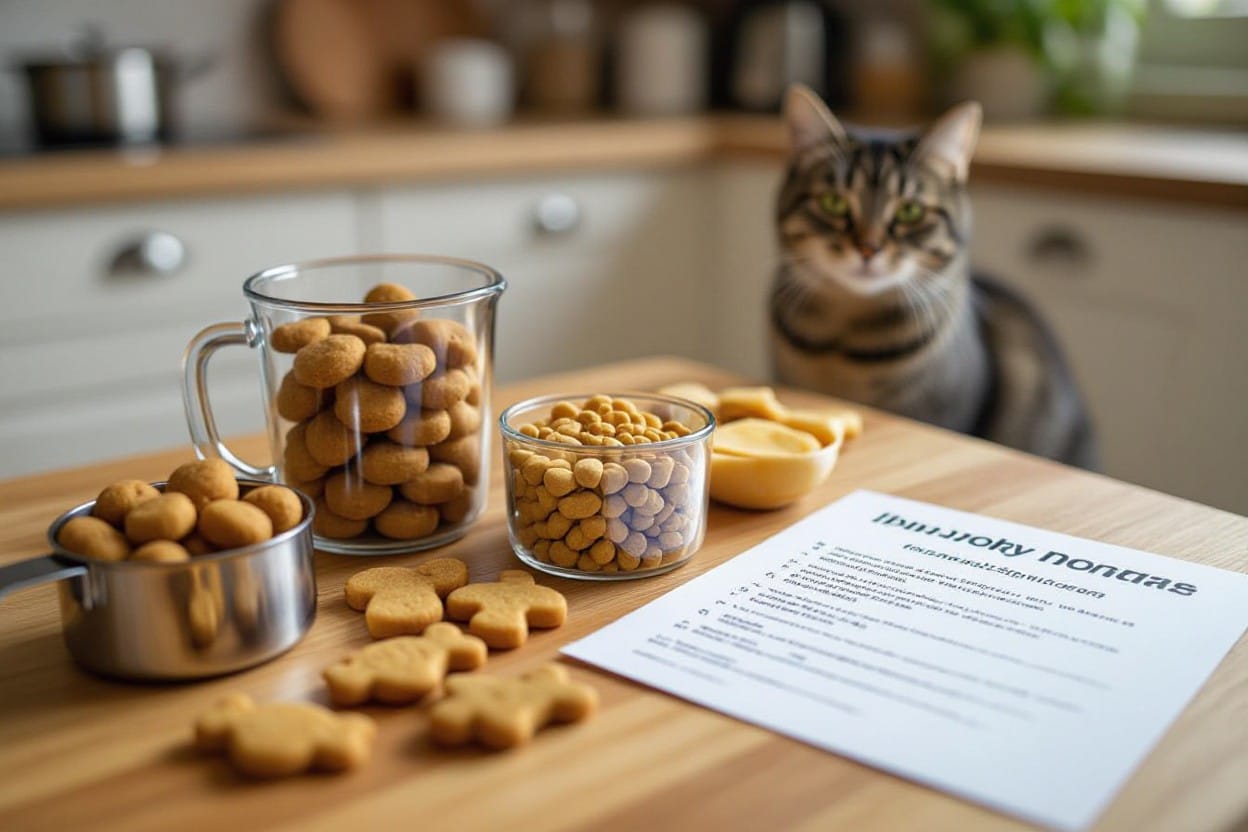There’s a growing need for allergy-friendly options in your cat’s diet, especially if your furry friend suffers from sensitive stomachs or allergies. Many commercial treats are packed with fillers and artificial ingredients that can worsen your pet’s condition. By providing homemade cat treats, you can control the ingredients and ensure they are safe and nutritious for your beloved companion. In this post, you will discover simple recipes that cater to your cat’s dietary restrictions and keep their tummy happy!

Key Takeaways:
- Using single-protein sources, such as chicken or fish, can help avoid allergens while catering to your cat’s sensitive stomach.
- Incorporate easy-to-digest ingredients like pumpkin or sweet potato, which can aid in digestion and provide additional nutrients.
- Always consult with a veterinarian before introducing new treats, especially if your cat has known food sensitivities or allergies.

Understanding Cat Allergies
For many cat owners, understanding allergies is crucial for ensuring your feline friend’s health and comfort. Cats can develop allergies to various substances, causing a range of issues from skin irritations to digestive problems. Identifying the allergens that affect your cat is the key to managing their symptoms and improving their quality of life. By being aware of common allergens and how they impact your cat’s wellbeing, you can take steps to create a safer environment for your beloved pet.
Common Allergens
Before venturing into homemade treats, it’s vital to identify common allergens that may affect your cat. Popular allergens include proteins found in fish, chicken, and beef, as well as grains like wheat and corn. Environmental factors such as pollen, dust mites, and certain chemicals may also contribute to allergies in cats. By keeping an eye on these substances, you can better cater to your cat’s unique dietary needs and sensitivities.
Symptoms of Allergic Reactions
One way to recognize if your cat is suffering from allergies is by observing specific symptoms. These may include frequent scratching, excessive grooming, or digestive issues such as vomiting and diarrhea. You may also notice redness, swelling, or rashes on your cat’s skin, which could indicate an allergic reaction. If you see these signs, it’s crucial to evaluate your cat’s diet and environment for possible allergens.
Reactions to allergens can vary in intensity, impacting your cat’s overall health. Some common symptoms to watch for include persistent itching, resulting in skin infections, or recurrent vomiting and diarrhea that may lead to dehydration. In severe cases, you might even observe difficulty breathing or swelling of the face and paws. If you encounter any of these concerning signs, it’s important to consult your veterinarian promptly to address your cat’s allergic reactions effectively.

Factors to Consider for Sensitive Stomachs
Some important factors to keep in mind for your cat’s sensitive stomach include their age, activity level, and specific dietary needs. Pay attention to:
- Existing allergies
- Food intolerances
- Digestive enzymes
- Feeding frequency
Assume that tailoring your cat’s treats to their unique gastrointestinal requirements will lead to better overall well-being.
Digestive Health in Cats
Against common misconceptions, a cat’s digestive health can significantly influence their energy levels, mood, and coat condition. Ensuring your cat’s digestive system operates smoothly is imperative for their overall health, particularly if they suffer from sensitivities. A diet rich in prebiotics and probiotics can help promote a healthy gut, reducing the occurrence of gastrointestinal issues.
Ingredients to Avoid
Consider steering clear of specific ingredients that can trigger digestive issues in your cat. Common food allergens include wheat, corn, soy, and certain proteins like beef or dairy. Additionally, avoid ingredients laden with artificial additives, which can be harsh on their stomachs and may lead to gastrointestinal distress. You should always check the labels, as some seemingly harmless ingredients can cause significant health concerns.
To provide the best treats for your cat, it’s imperative to eliminate any potentially harmful ingredients that can worsen their condition. Ingredients like onions, garlic, and excessive fat content can lead to severe health issues, such as hemolytic anemia or pancreatitis. By carefully selecting safe, wholesome components, you’ll not only cater to your cat’s preferences but also support their overall health and prevent adverse reactions.

Nutritional Requirements for Cats
Keep in mind that your cat’s nutritional needs are unique, as they are obligate carnivores. This means their diet must primarily consist of high-quality protein and crucial nutrients to support their overall health. It’s important to provide a balanced diet, focusing on animal-based proteins, fats, vitamins, and minerals that cater to their specific sensitivities, ensuring they thrive while avoiding stomach issues.
Essential Nutrients
On the spectrum of nutrients, cats require protein, fat, taurine, vitamins A, B, and E, as well as minerals like calcium and phosphorus. Each of these components plays a vital role in maintaining your cat’s energy levels, coat condition, and overall well-being. Providing a balanced mix in their diet is crucial for keeping your furry friend healthy and happy.
Safe Ingredients for Treats
Beside focusing on the right nutrients, selecting safe ingredients for cat treats is crucial. Many common foods can be harmful to your feline friend, so it’s best to avoid ingredients like onions, garlic, chocolate, or artificial additives. Instead, opt for easily digestible, nutritious options like cooked chicken, fish, or pumpkin to create tasty treats that won’t upset your cat’s sensitive stomach.
Due to the potential dangers in some common ingredients, you should be vigilant when choosing components for your homemade cat treats. Stick with natural, high-quality proteins like chicken or turkey, and add safe vegetables like carrots or sweet potatoes in moderation. Avoid any ingredients known to be toxic to cats, such as onions or grapes, as they can cause serious health issues. By being cautious and selecting wholesome, digestible ingredients, you can ensure your cat enjoys delicious treats without the risk of upsetting their tummy.
Homemade Treat Recipes
Many cat owners struggle with finding the right treats for their pets with sensitive stomachs. Fortunately, homemade treats provide a fantastic solution, as you can control the ingredients and ensure they are allergy-friendly. Below are two simple recipes that are not only delicious but also gentle on your cat’s digestive system.
Chicken and Pumpkin Treats
One easy recipe to try is Chicken and Pumpkin Treats. Begin by mixing canned pumpkin with cooked, shredded chicken and a bit of oat flour. Roll the mixture into small balls and bake them until firm. These treats are not only tasty but also provide a fiber boost to aid digestion, making them ideal for cats with sensitive stomachs.
Fish and Sweet Potato Bites
Treats made from fish and sweet potatoes offer a nutritious option for your feline friend. Combining cooked sweet potato with canned tuna or salmon creates a protein-rich treat that is gentle on the stomach. To enhance the flavor, you can add a sprinkle of catnip. These bites are great for picky eaters!
To make these Fish and Sweet Potato Bites, mash together cooked sweet potatoes and canned fish of your choice, ensuring it is packed in water and free from harmful additives. You can shape them into bite-sized pieces and either bake them or refrigerate for a cool treat. This recipe is not only easy to prepare, but it is also rich in omega-3 fatty acids, which promote healthy skin and coat. Always verify that the fish used does not contain any bones, and avoid any seasonings that could upset your cat’s stomach.
Tips for Introducing New Treats
Despite the excitement of offering your cat new treats, it’s necessary to do so thoughtfully to avoid upsetting their sensitive stomachs. Consider these tips:
- Start with small portions.
- Choose single-ingredient treats.
- Observe your cat’s reaction before increasing the amount.
- Mix new treats with their regular food for a gradual transition.
Recognizing your cat’s unique needs will help make introduction smoother and safer.
Gradual Introduction
Against common practice, you should avoid immediately switching your cat’s treats. Instead, introduce new options gradually over several days. This method allows your cat’s digestive system to adapt, minimizing the risk of gastrointestinal upset. Start by offering a tiny amount of the new treat alongside their usual ones and observe how they react.
Monitoring for Reactions
Introducing new treats requires vigilance, as you need to watch for any adverse effects. Assess your cat for signs of allergic reactions, such as vomiting, diarrhea, or unusual behavior. If you notice any of these symptoms, discontinue the treat immediately. It’s advisable to consult your veterinarian for further guidance.
Hence, keeping a close eye on your cat after introducing new treats is necessary. Look for any signs of distress like excessive drooling, changes in appetite, or lethargy. If your cat experiences any serious symptoms, such as severe vomiting or diarrhea, seek veterinary care without delay. By being proactive, you can ensure your pet’s safety while trying new, allergy-friendly treats.
Storing and Preserving Treats
Unlike store-bought treats that often contain preservatives, homemade cat treats require careful storage to ensure their freshness and safety. It’s necessary to keep them in airtight containers to prevent moisture and bacteria from ruining your efforts. You should also store them in a cool, dark place or even in the refrigerator for longer-lasting quality while ensuring that your kitty has easy access to their delicious snacks.
Best Storage Practices
On storing your homemade cat treats, you should opt for airtight containers or resealable bags. These will protect the treats from air exposure, which can lead to spoilage. If you prefer freezing, portion your treats before freezing them, allowing you to take out only what you need. This approach not only maintains freshness but also makes it convenient for your feeding schedule.
Shelf Life of Homemade Treats
Shelf life varies based on the ingredients used but generally ranges from a few days to a couple of weeks. For optimal freshness, store treats in the refrigerator, where they can last up to two weeks. In the freezer, you can preserve them for up to three months, ensuring that your furry friend always has safe, tasty options available.
Even though homemade treats can be healthier and tastier for your kitty, you must pay attention to their shelf life. Improperly stored treats may develop mold or spoil, which could lead to stomach issues or illness in your cat. It’s best to check for any signs of spoilage, such as an off smell or unusual texture, before serving. Always aim to consume or freeze them well within their designated shelf life to ensure that your feline friend enjoys nutritious and safe treats.
Conclusion
Hence, by crafting allergy-friendly homemade cat treats tailored for sensitive stomachs, you can ensure your feline friend enjoys tasty snacks without discomfort. Utilizing safe, natural ingredients not only supports their health but also strengthens the bond between you and your pet. Take the time to explore different recipes and find the perfect fit for your cat’s unique dietary needs. Your commitment to their well-being will result in a happier, healthier companion.
Q: What ingredients are safe for making allergy-friendly cat treats for sensitive stomachs?
A: When preparing allergy-friendly cat treats, opt for simple, wholesome ingredients that are known to be easier on sensitive stomachs. Common options include pumpkin puree, cooked and mashed sweet potatoes, plain cooked chicken or turkey, and oat flour. Avoid common allergens such as wheat, soy, and corn. Additionally, always check for any specific food sensitivities your cat may have before introducing new ingredients.
Q: How can I ensure the treats are palatable for my cat?
A: To make sure your homemade treats are appealing to your cat, use combinations of flavors and textures that they enjoy. Incorporate some cat-friendly herbs, like catnip or parsley, for added flavor. Baking the treats until they are crunchy may also enhance their attractiveness, as many cats enjoy a crunchy texture. You can even experiment with different shapes using cookie cutters to make the treats visually appealing.
Q: How can I store homemade cat treats to maintain freshness?
A: To keep your homemade cat treats fresh, store them in an airtight container in a cool, dry place. These treats can typically last for about a week at room temperature. For longer shelf life, consider refrigerating them, which can extend freshness up to two weeks. If you want to keep them for an even longer period, freezing is an option; just ensure they are well-sealed to prevent frostbite. When ready to use, thaw them at room temperature before serving.














